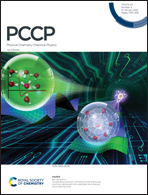Ultrafast channel I and channel II charge generation processes at a nonfullerene donor–acceptor PTB7:PDI interface is crucial for its excellent photovoltaic performance†
Abstract
Nonfullerene organic solar cells have received much attention in recent years due to their low cost, high absorption coefficient and excellent synthetic flexibility. However, the microscopic photoinduced dynamics at corresponding donor–acceptor interfaces remains unclear. In this work, we have firstly employed state-of-the-art TDDFT-based nonadiabatic dynamics simulations in combination with static electronic structure calculations to explore the ultrafast photoinduced dynamics at a typical nonfullerene donor–acceptor PTB7:PDI interface using a minimal model system (172 atoms). Upon excitation with specific wavelength of light, both PTB7 and PDI can be locally excited to generate |PTB7*〉 and |PDI*〉 excitons due to their high absorption ability and significant overlap in absorption spectrum. After that, these localized excitons gradually convert to charge transfer exciton |PTB7+PDI−〉, while another |PTB7−PDI+〉 charge transfer exciton is not involved in the whole process. Along with the exciton conversion, electron transfer from PTB7 to PDI (channel I charge generation) and the hole transfer from PDI to PTB7 (channel II charge generation) occurs simultaneously with time constants of 643 fs and 549 fs respectively. In the same time, D index that measures the centroid distance of electron and hole increases from 1.0 Å to 4.0 Å, which clearly reflects a charge transfer process at the interface. Our present work provides solid evidence that both channel I and channel II charge generation processes play important roles at PTB7:PDI interface, which could be helpful for the design of novel nonfullerene solar cells with better photovoltaic performance.



 Please wait while we load your content...
Please wait while we load your content...